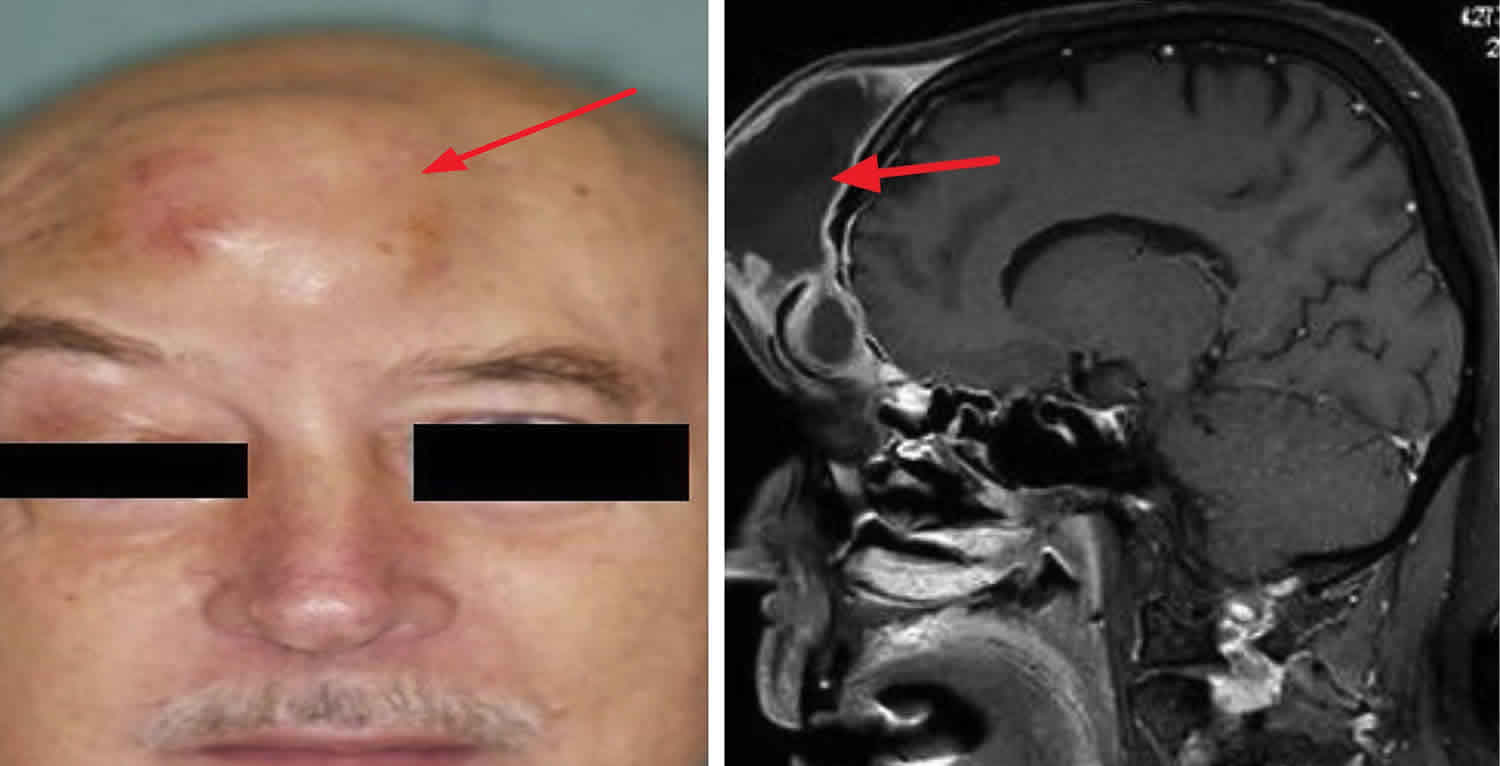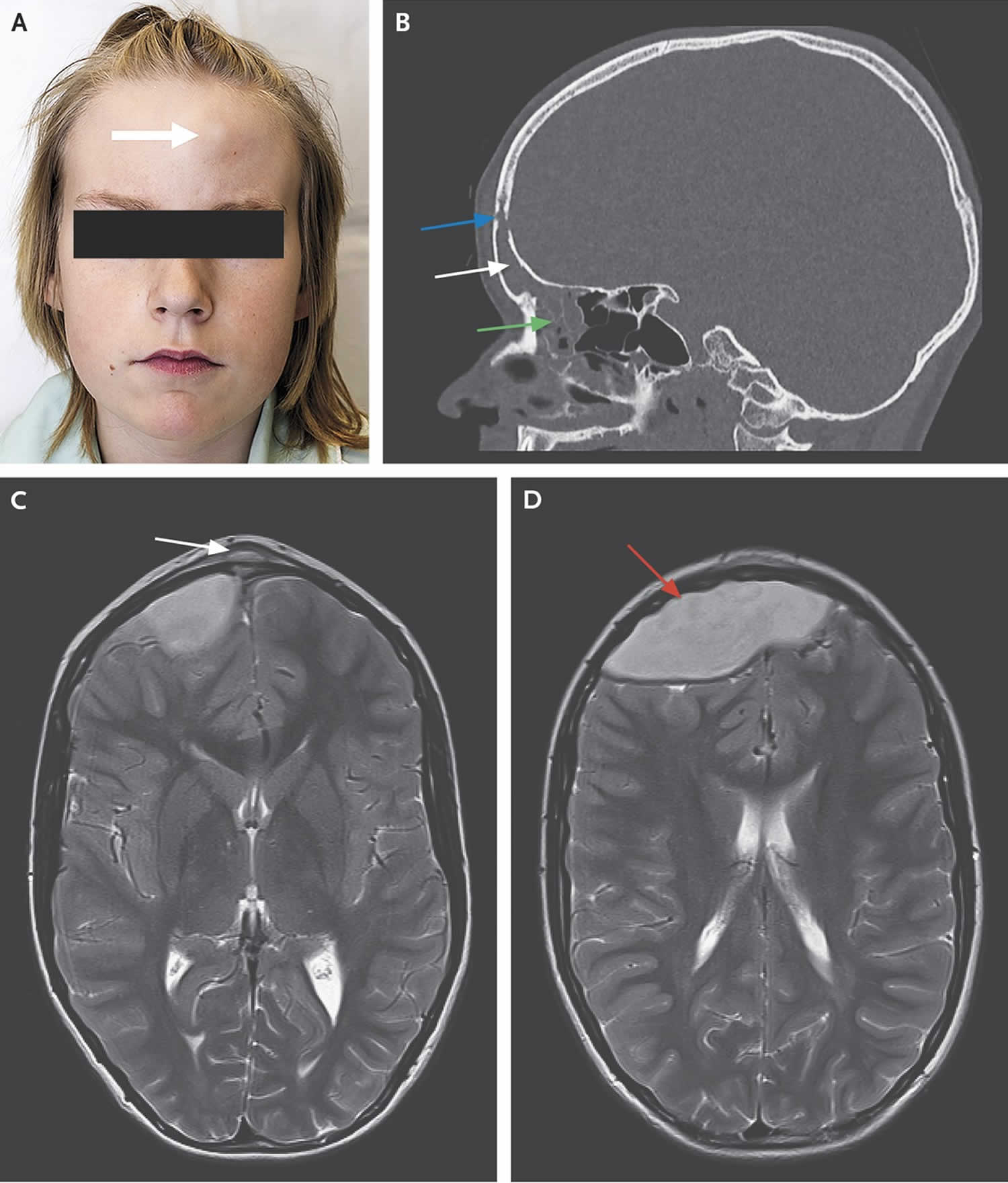Pott’s puffy tumor
Pott’s puffy tumor is a surgical emergency and an extremely rare complication of frontal sinusitis 1. Pott’s puffy tumor is characterized by osteomyelitis of the frontal bone with an associated subperiosteal abscess 2. The infection in Pott’s puffy tumor typically spreads from the frontal sinus into the frontal bone via direct extension or through septic emboli 3. Pott’s puffy tumor is a serious condition because it is associated with high rate of intracranial complications such as meningitis, subdural and epidural empyema, cerebral abscess, and cavernous sinus thrombosis or superior sagittal sinus thrombosis 4.
Pott’s puffy tumor can affect all age groups and has a male: female ratio of 9:1 5. It is noted that adolescents are affected more frequently. This is thought to be due to high vascularity of the diploic venous system, and the accelerated growth of the frontal bone at this particular age 6. The most common factors leading to Pott’s puffy tumor are frontal sinusitis and trauma 7. Other rare causes include hematogenous spread of sinusitis, retrograde thrombophlebitis through the diploic veins, or even an insect bite 8. Signs and symptoms of Pott’s puffy tumor include forehead swelling and frontal headaches with or without fever. These clinical manifestations usually progress slowly, however, rapid progression may suggest the development of complications 9. The most common cultured organisms are the same organisms causing chronic sinusitis: streptococci, staphylococci, and anaerobes 10.
The diagnostic modality is the contrast enhanced CT scan of the brain and sinuses. The most important aspect in the management of Pott’s puffy tumor is early diagnosis, early use of proper antimicrobial therapy, and urgent surgical intervention to prevent serious complications 11.
Due to the wide use of broad spectrum antibiotics, Pott’s puffy tumor incidence has dramatically decreased 5, but the exact incidence is unknown. However, Clayman et al 12 found that Pott’s puffy tumor may be seen in up to 0.5% of cases of acute and chronic sinusitis.
Figure 1. Pott’s puffy tumor
Footnotes: A previously healthy 13-year-old boy presented to the otorhinolaryngology clinic with soft, well-demarcated, painless swelling of the forehead (Panel A, arrow). He had no definite symptoms of sinusitis but had had a headache and fluctuating fever for 3 weeks. He had no neurologic deficit or abnormality on physical examination. A blood chemical profile showed a C-reactive protein level of 29 mg per liter and a white-cell count of 11,900 per cubic millimeter. Computed tomography revealed unilateral opacification of the left frontal and ethmoid sinuses (Panel B, white and green arrows, respectively) as well as defects in the frontal bone (Panel B, blue arrow). T2-weighted axial magnetic resonance images (MRIs) showed a subperiosteal abscess in the forehead (Panel C, arrow) and a 3 cm×5 cm×8 cm epidural abscess (Panel D, arrow). There was no involvement of the venous sinuses. A combined neurosurgical and otolaryngologic approach was used to surgically manage the frontal sinusitis and associated epidural abscess. Cultures grew Streptococcus intermedius. The patient was treated with intravenous antibiotic agents for 4 weeks after surgery. He remained well, with no neurologic sequelae or residual abscess observed clinically or on follow-up MRI obtained 1 month after drainage.
[Source 13 ]Pott’s puffy tumor causes
The most common factors leading to Pott’s puffy tumor are frontal sinusitis and trauma 7. Other rare causes include hematogenous spread of sinusitis, retrograde thrombophlebitis through the diploic veins, or even an insect bite 8. The most common cultured organisms are the same organisms causing chronic sinusitis: streptococci, staphylococci, and anaerobes 10. The most commonly cultured organisms in Pott’s puffy tumor are Streptococci, mainly Streptococcus milleri which was found in approximately 50% of the reported cases, Staphylococci, anaerobes, namely Fusobacterium and Bacteroides, and less commonly Proteus and Pseudomonas 14.
Pott’s puffy tumor symptoms
Signs and symptoms of Pott’s puffy tumor include forehead swelling and frontal headaches with or without fever. These clinical manifestations usually progress slowly, however, rapid progression may suggest the development of complications 9.
Pott’s puffy tumor diagnosis
In regards to diagnosis, computed tomography (CT) of the brain is the best diagnostic modality in Pott’s puffy tumor cases. It helps in the critical assessment of the sinuses as well as gauging the extent of the disease to rule out any intracranial complications 15.
Pott’s puffy tumor treatment
Pott’s puffy tumor is considered to be an emergency medical condition, and broad spectrum antibiotics should be initiated as soon as possible along with urgent surgical intervention which may include: sinus wash-outs, percutaneous aspiration, trepanation, endoscopic sinus surgery, or craniotomy 16. Functional endoscopic sinus surgery is a safe and less invasive surgical procedure 17. The decision of whether or not a craniotomy is indicated depends on the size of the intracranial fluid collection 18. Antimicrobial therapy should be tailored according to the cultured organism 19.
- Suwan PT, Mogal S, Chaudhary S. Pott’s puffy tumor: an uncommon clinical entity. Case Rep Pediatr 2012;2012:4.[↩]
- Babu RP, Todor R, Kasoff SS. Pott’s puffy tumor: the forgotten entity. J Neurosurg 1996;84:110–12.[↩]
- Pott P. Observations on the Nature and Consequences of Wounds and Contusions of the Head. C Hitch and L Hawes 1760.[↩]
- Tsai B.Y., Lin K.L., Lin T.Y., Chiu C.H., Lee W.J., Hsia S.H. Pott’s puffy tumor in children. Childs Nerv Syst. 2010;26:53–60.[↩]
- AlMoosa ZA, AlFawaz T, AlFawaz F. Pott’s puffy tumor due to Aspergillus fumigatus: A case report and review. Int J Pediatr Adolesc Med. 2016;3(3):128–131. doi:10.1016/j.ijpam.2016.08.005 https://www.ncbi.nlm.nih.gov/pmc/articles/PMC6372439[↩][↩]
- Shehu B.B., Mahmud M.R. Pott’s puffy tumour: a case report. Ann Afr Med. 2008;7:138–140.[↩]
- Emejulu J.C., Ekweogwu O.C. Complicated Pott’s Puffy Tumour Involving both Frontal and Parietal Bones: A Case Report. J Infect Dis Ther. 2014;2(5):166.[↩][↩]
- Raja V., Low C., Sastry A., Mariarty B. Pott’s puffy tumor following an insect bite. J Postgrad Med. 2007;53(2):114–116.[↩][↩]
- Forgie Sarah E. Pott’s puffy tumor. Am J Med. 2008;121(12).[↩][↩]
- Verbon A., Husni R.N., Gordon S.M., Lavertu P., Keys T.F. Pott’s puffy tumor due to Haemophilus influenzae: case report and review. Clin Infect Dis. 1996;23:1305–1307.[↩][↩]
- Parida Pradipta Kumar. Pott’s puffy tumor in pediatric age group: a retrospective study. Int J Pediatr Otorhinolaryngol. 2012;76:1274–1277.[↩]
- Clayman G.L., Adams G.L., Paugh D.R., Koopmann C.F., Jr. Intracranial complications of paranasal sinusitis: a combined institutional review. Laryngoscope. 1991;101:234–239.[↩]
- Frontal Sinusitis Causing Epidural Abscess and Puffy Tumor. N Engl J Med 2014; 370:e18 https://www.nejm.org/doi/10.1056/NEJMicm1307740[↩]
- Wu C.T., Huang J.L., Hsia S.H., Lee H.Y., Lin J.J. Pott’s puffy tumor after acupuncture therapy. Eur J Pediatr. 2009;168(9):1147–1149.[↩]
- Martinez-Diaz G.J., Hsia R. Pott’s Puffy tumor after minor head trauma. Am J Emerg Med. 2008;26(6):739.[↩]
- Fenton J.E., Smyth D.A., Viani L.G., Walsh M.A. Sinogenic brain abscess. Am J Rhinol. 1999;13:299–302.[↩]
- Suwan Phillip T. Pott’s puffy tumor: an uncommon clinical entity. Case Rep Pediatr. 2012;2012:4. doi: 10.1155/2012/386104[↩]
- DelGaudio J.M., Evans S.H., Sobol S.E., Parikh S.L. Intracranial complications of sinusitis: what is the role of endoscopic sinus surgery in the acute setting. Am J Otolaryngol. 2010;31:25–28.[↩]
- McDermott C., O’Sullivan R., McMahon G. An unusual cause of headache: Pott’s puffy tumor. Eur J Emerg Med. 2007;14(3):170–173.[↩]






